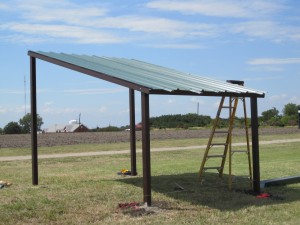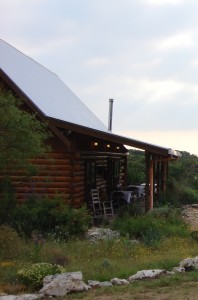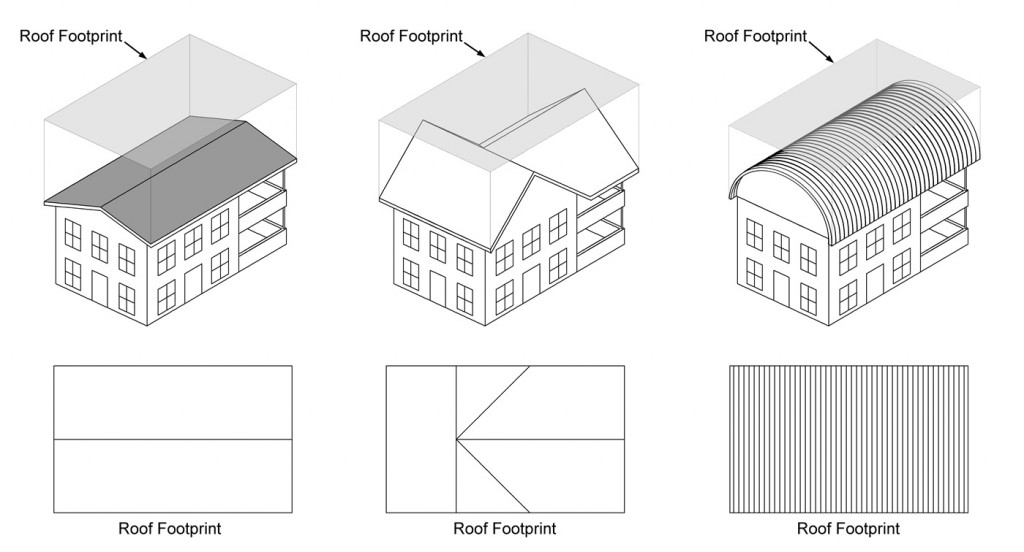The catchment area is the first point of contact for rainfall. For the vast majority of tank-based rainwater harvesting systems, the catchment area is the roof surface. There are some important factors about the roof to consider when planning for a RWH system:
 Roof Material – The material of the roof is not as important as contaminants that may be on the roof. For landscape purposes, the common asphalt shingle will work fine. If you are starting from scratch, we recommend a metal roof because they easily shed contaminants. In all cases, it’s important to avoid wood shingles or metal flashing that contains lead.
Roof Material – The material of the roof is not as important as contaminants that may be on the roof. For landscape purposes, the common asphalt shingle will work fine. If you are starting from scratch, we recommend a metal roof because they easily shed contaminants. In all cases, it’s important to avoid wood shingles or metal flashing that contains lead.
 Slope – The slope of the roof affects how quickly water will runoff during a rain event. A steep roof will shed runoff quickly and more easily clean the roof of contamination. A less-steep, flatter roof will cause the water to move more slowly, raising the potential for contamination to remain on the catchment surface. The roof on the right has a steep slope followed by a more gradual slope.
Slope – The slope of the roof affects how quickly water will runoff during a rain event. A steep roof will shed runoff quickly and more easily clean the roof of contamination. A less-steep, flatter roof will cause the water to move more slowly, raising the potential for contamination to remain on the catchment surface. The roof on the right has a steep slope followed by a more gradual slope.
Sizing a Catchment Area – The size of the catchment area or roof will determine how much rainwater that you can harvest. The area is based on the “footprint” of the roof, which can be calculated by finding the area of the building and adding the area of the roof’s overhang. The image below shows how differences in roof slope do not change this building’s catchment area.
To calculate how much rainwater that you can harvesting, use the equation below. A more detailed computer calculator can be found at the Calculators page.

Pingback: Gutters: Why They are So Important for Your Home - Plant Nativ
Pingback: Rainwater Storage | reclaimedlivingblog
Pingback: Nature Is Full of Naturally Existing Cycles: The Goal for Humanity is to Provide the Missing Link to Complete Them | Home | Graphite Publications
Pingback: Five Steps of Rainwater Harvesting - Mark Peterson
Pingback: Tiny House Offers 17 Liveabilty Checklist | tinyhouseonwheelsforsalearizona
Pingback: The Essential Farm Shed for Your Sustainable Farm – Interior Design, Design News and Architecture Trends
Pingback: Rainwater Calculator – Efficiency is Innovation
Pingback: Rain, Rain Go Away – Livin' Off Grid
Pingback: A roof of possibilities – Cottage Street Gardens
Pingback: Catching Rain – DIY yards
Pingback: Mini Cordwood House Plans: Energy Efficiency – Homestead Houligan
Pingback: Four Ways to Grow More with Less Water – Momma Lori's 2 Cents
Pingback: Pingback Test - Teknobilgi | Güncel Bilgi Sitesi | Otomobil , Sosyal Medya, Dizi , Hukuk Haberleri Güncel Fiyatlar
Pingback: Can I Collect Rainwatr In Oregon? – Loup City
Pingback: Can You Catch Rainwater In Oregon? – Loup City
Pingback: Can You Store Rain Barrels In Oregon? – Loup City
Pingback: Use Rainwater for Gardening to Grow Healthy Plants - Resourceful Home
Pingback: 14 Ways To Find Water in the Wilderness – freedomroad23
Pingback: Nature-Inspired Landscapes with Dry Stream Beds